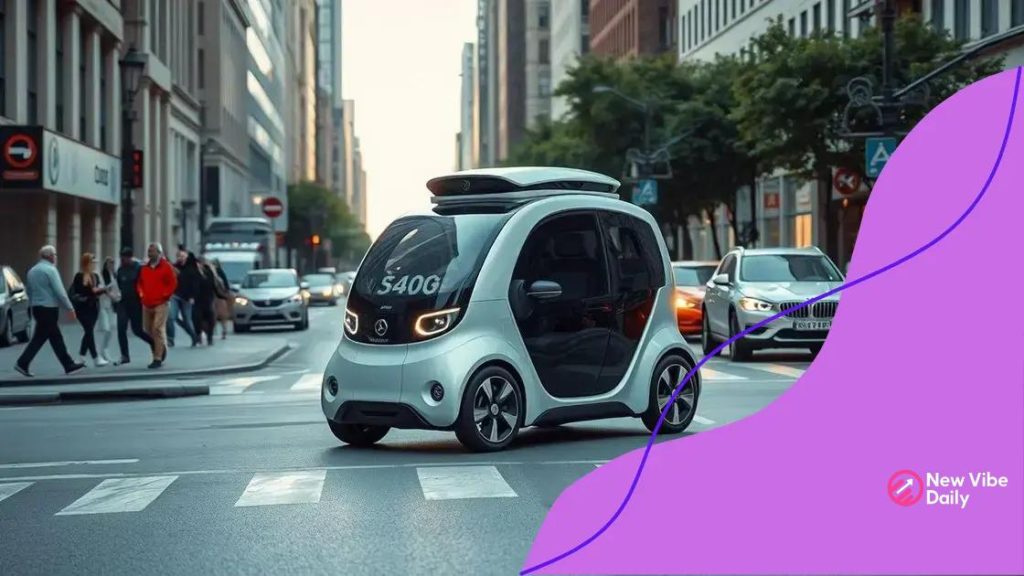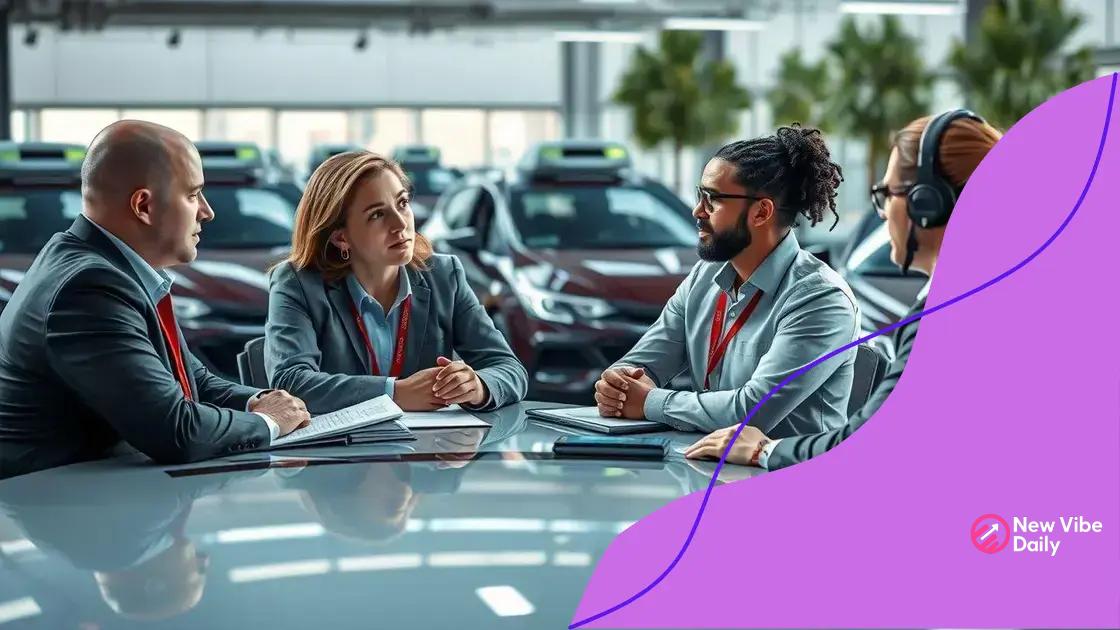The future of autonomous vehicles and transportation

The future of autonomous vehicles and transportation includes advancements in electric vehicles, smart city technologies, and various innovative mobility solutions like flying taxis and micro-mobility options that enhance urban efficiency and sustainability.
The future of autonomous vehicles and transportation is not just coming; it’s already here in various forms. Have you ever wondered how self-driving cars will reshape your daily commute? Let’s delve into this fascinating topic.
Understanding autonomous vehicles
Understanding autonomous vehicles is crucial as we move toward a future where self-driving technology becomes commonplace. These vehicles are designed to navigate and operate without human intervention, using advanced sensors, cameras, and machine learning algorithms.
One key aspect is how these vehicles interpret their surroundings. They rely heavily on various technologies that allow them to detect obstacles, understand traffic signals, and respond accordingly. The use of artificial intelligence enables autonomous vehicles to learn from their environment, improving safety and efficiency over time.
How do autonomous vehicles work?
Autonomous vehicles utilize a combination of hardware and software to function seamlessly.
- Sensors: LiDAR, radar, and cameras gather real-time data about the environment.
- Machine Learning: Algorithms process and analyze the data to make decisions.
- Connectivity: Vehicles communicate with each other and infrastructure to enhance safety.
This integration of technologies enhances the ability of autonomous vehicles to perform tasks like lane changing and parking with minimal human input. As they evolve, we can expect significant advancements that will redefine mobility.
Types of autonomous vehicles
There are several levels of automation in vehicles, classified by the Society of Automotive Engineers (SAE). These levels indicate the degree to which a vehicle can operate without human intervention.
- Level 0: No automation, requiring full driver control.
- Level 2: Partial automation, where vehicles can control steering and acceleration.
- Level 5: Full automation, capable of operating independently in any environment.
As manufacturers continue to innovate, the distinction between levels will become important for regulatory standards and consumer understanding. The public’s eventual acceptance of autonomous vehicles will largely depend on their safety and reliability, which gives manufacturers a significant responsibility.
In exploring the concept of autonomous vehicles, it’s essential to consider both their potential and the hurdles we face. These vehicles promise to enhance mobility, while also raising questions about ethics, employment, and traffic laws. Embracing these changes will require open discussions and careful consideration as we shape the future of transportation.
The impact on urban transportation
The impact on urban transportation is significant as autonomous vehicles take center stage in modern transit systems. These vehicles not only promise to change how we travel but also how cities are designed and integrated.
As autonomous vehicles become more common, they will reshape urban landscapes. With fewer parking lots needed, cities could reclaim space for parks, bike lanes, and pedestrian areas. Imagine walking or biking through an area previously dominated by parked cars.
Benefits of autonomous vehicles in cities
Autonomous vehicles can enhance urban living through various means. Here are some benefits:
- Reduced traffic congestion: With smart routing and shared autonomous systems, cities can see a decrease in overall traffic.
- Lower emissions: Many autonomous vehicles are electric, contributing to cleaner air and reducing the carbon footprint.
- Increased safety: Autonomous vehicles are designed to minimize accidents caused by human error, enhancing overall road safety.
The reduction of personal vehicle ownership is another aspect to consider. As ridesharing services grow, fewer people may feel the need to own a car. This shift can lead to decreased traffic and lower parking demand in densely populated areas. Public transport systems may also adapt to integrate autonomous technologies, offering on-demand shuttle services to complement existing routes.
Challenges to consider
While the benefits of autonomous vehicles are exciting, several challenges also arise. Urban planners need to consider how to integrate these technologies into existing infrastructure effectively. There is also the potential for increased inequality if access to autonomous transportation remains limited to certain populations.
Moreover, as cities change, local governments must ensure that services are equitable and that communities are not left behind. Balancing innovation with inclusivity is key to sustainable urban transportation in the future.
Overall, embracing autonomous vehicles will redefine cities, making them more efficient and sustainable. However, careful consideration and planning are necessary to ensure these changes benefit all residents.
Safety and regulatory challenges

Safety and regulatory challenges are critical considerations as we move toward a future dominated by autonomous vehicles. While these technologies promise improved road safety, they also bring new risks that require careful management.
One of the primary concerns is ensuring that autonomous vehicles operate safely under various conditions. Factors such as poor weather, road construction, or unexpected obstacles can pose challenges. Manufacturers must conduct extensive testing to address these issues and ensure the vehicles can respond effectively.
Regulatory hurdles
Governments play a crucial role in the safe integration of autonomous vehicles. Regulations need to evolve to accommodate these new technologies. Some key aspects include:
- Establishing safety standards: Clear guidelines must be set for manufacturers to verify that their vehicles meet rigorous safety criteria.
- Liability frameworks: Determining who is responsible in the event of an accident involving an autonomous vehicle remains a complex legal question.
- Creating testing protocols: Regulatory bodies need to define how autonomous vehicles should be tested before they are allowed on public roads.
Several countries have already begun to draft regulations, but there remains significant variation worldwide. This inconsistency can make it challenging for manufacturers to operate across different markets.
Public perception and trust
Building public trust in autonomous vehicle technology is another essential challenge. Many people are concerned about the safety and reliability of these vehicles. High-profile incidents involving self-driving cars can exacerbate fears and create more resistance to their adoption.
Education and transparent communication from manufacturers are vital to address these concerns. Demonstrating that advanced safety measures are in place can help ease public anxiety and promote acceptance.
Moreover, collaboration between automotive companies and regulatory agencies is crucial to building a solid framework for the future. It is essential to ensure that safety remains a top priority as autonomous vehicles become more prevalent on our roads.
Technological advancements in self-driving
Technological advancements in self-driving vehicles have accelerated rapidly in recent years, making them a key focus in the automotive industry. These innovations are transforming how we perceive transportation, safety, and mobility.
At the core of these advancements is the enhancement of sensors and perception systems. These components are vital for self-driving cars to gather accurate information about their surroundings. High-definition cameras, LiDAR, and radar work together to create a detailed map of the environment, allowing vehicles to navigate safely.
Key technologies driving self-driving vehicles
Several technologies contribute to the effectiveness of self-driving vehicles:
- Artificial Intelligence (AI): AI algorithms analyze data from sensors to make real-time decisions, mimicking human-like judgment while driving.
- Machine Learning: This allows vehicles to improve their performance over time by learning from driving experiences and situations, adapting to new road conditions.
- Vehicle-to-Everything (V2X) communication: This technology enables vehicles to communicate with each other and with infrastructure, enhancing traffic flow and safety.
The integration of these technologies permits self-driving cars to respond effectively to various situations, such as navigating through heavy traffic or interpreting complex intersections. As the technology matures, we expect more sophisticated systems that can handle increasingly complex scenarios.
The role of simulation and testing
Simulation is crucial for the development of self-driving technology. By testing vehicles in virtual environments, manufacturers can safely assess how their systems respond to diverse driving conditions without the risks associated with on-road testing. This helps in identifying potential issues early and refining the algorithms used in the vehicles.
Furthermore, as the technology evolves, it’s important to focus on the ethical implications. Developers must consider how their systems will respond in emergency situations, ensuring that the programming aligns with societal values and safety standards.
In summary, the advancements in self-driving technology hold great promise for revolutionizing transportation. By enhancing safety, efficiency, and connectivity, they pave the way for a new era of mobility.
Future trends in transportation
Future trends in transportation are shaping the way we think about mobility and urban planning. As we enter a new era filled with technological advancements, our transportation systems are poised for significant changes.
One of the key trends is the rise of electric vehicles (EVs). With the increasing focus on sustainability, more manufacturers are investing in EV technology. As battery technology advances, electric vehicles are becoming more efficient and affordable, encouraging widespread adoption.
Emerging modes of transportation
In addition to electric vehicles, other innovative modes of transport are emerging:
- Micro-mobility solutions: E-scooters, bikes, and other small vehicles provide convenient options for short trips, helping reduce congestion.
- Hyperloop technology: This proposed mode of high-speed transport promises to connect cities quickly and efficiently, potentially reshaping commuter travel.
- Flying taxis: Companies are working on aerial mobility solutions to reduce urban congestion by taking transport to the skies.
These innovations highlight how transportation is evolving to meet the demands of a growing population while addressing environmental concerns.
The role of smart cities
As cities integrate smart technologies, they create environments that improve transportation efficiency. Smart infrastructure includes traffic management systems that use real-time data to optimize the flow of vehicles and reduce congestion. This technology helps to enhance safety and improve overall travel times.
Additionally, public transportation systems are also evolving. With the incorporation of autonomous vehicles, cities can offer on-demand transit services, making public transport more adaptable to individual needs. These changes aim to make public transit more reliable and user-friendly, encouraging people to choose this option over personal vehicles.
Furthermore, sustainability remains a priority. Many cities are adopting policies to promote green transportation, such as investing in renewable energy sources for transit systems and encouraging multi-modal transportation options that allow for seamless travel from one mode to another.
FAQ – Frequently Asked Questions about the Future of Autonomous Vehicles and Transportation
What are autonomous vehicles?
Autonomous vehicles are cars or trucks that can drive themselves without human input, using sensors and AI to navigate.
How will electric vehicles impact urban transportation?
Electric vehicles will reduce air pollution and can help decrease traffic congestion, making cities more environmentally friendly.
What role do smart cities play in transportation?
Smart cities use technology to improve transportation efficiency, safety, and sustainability through better traffic management and smart infrastructure.
What are some emerging trends in transportation?
Emerging trends include electric vehicles, micro-mobility solutions like e-scooters, flying taxis, and enhanced public transportation systems.






